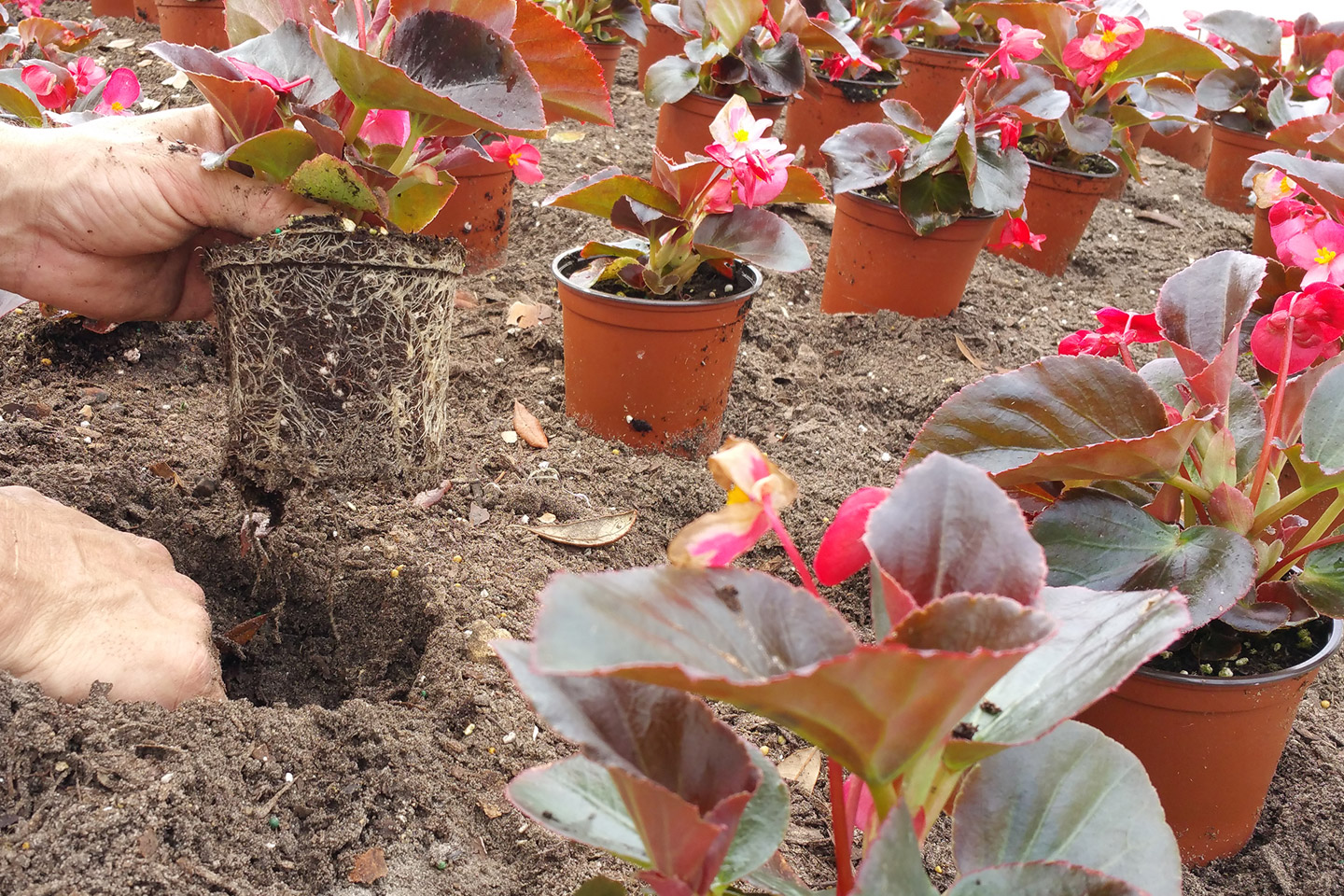6 Common Palm Diseases - What They Are, and How to Identify & Fix the Problem - Sit Down with CEPRA
Palm tree diseases are relatively common in Florida. Understanding the diseases that afflict palm trees is critical to maintain your properties health, beauty, and value.
Six of the most common disease are as follows:
Petiole (Rachis) Blight of Palm
What is it? This disease was first observed on Phoenix palms. Mature palms are more likely to be affected by Petiole Blight than juvenile palms. Little is known about petiole blight, including the specific environmental conditions that encourages this fungal disease. The disease will only affect the petiole and not the leaf tissue. However, It can destroy the vascular tissue deep inside the petiole that can result in a one-sided or uneven death in the leaf blade. This disease seldom kills the palm.
In Phoenix species, Queen palms, and Washingtonia species, the symptoms appear similar to those caused by Fusarium wilt, which is a lethal disease. Only a lab diagnosis can differentiate the cause of the symptoms observed in these three palm genera.
Symptoms: This disease will produce elongated brown or reddish-brown lesions or streaks that will be found along the petiole/rachis of the oldest leaves.
Remedies: Petiole Blight disease can be managed by the sanitation of pruning devices, water management and when necessary, a fungicide application. A fungicide application will not cure the damage already present on the palm. Once the damage occurs, it will remain for the duration of the life of that particular leaf. Fungicides are used to prevent the further spread of the disease by protecting a leaf petiole and rachis that has not yet been infected.

Pygmy Date Palm - reddish brown lesions
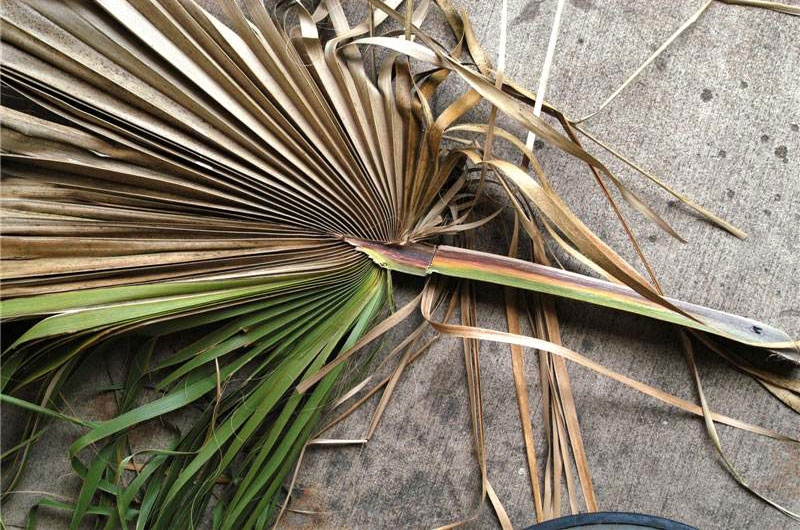
Washingtonia Palm - one sided streaking
Fusarium Wilt
What is it? Fusarium Wilt is a lethal disease that has the ability to be spread through soil, airborne transmission and by the use of infected pruning equipment. This disease can affect Canary Island Date Palm, Queen palm and Mexican Fan Palms (Washingtonia). It can survive in the soil, so when a palm dies from this disease, it should not be replaced with another susceptible palm species. This fungus affects the palm by blocking its vascular system, which inhibits the transportation of water throughout the palm.
Symptoms: Symptoms include yellowing or dead leaflets which will start on one side of the leaf blade. The disease typically begins on the lower leaves and eventually migrates upwards to the bud. It causes the leaves of the palms to take on a browned, freeze-dried look. The palm will typically die within two to three months after symptoms first appear.
Remedies: It is thought that over-pruning can render palms more susceptible to the disease. Currently there is no cure or recommended treatment for palms infected with this fungal disease. The best defense is sanitization of pruning equipment and the quick removal of any palms from the landscape that are infected.
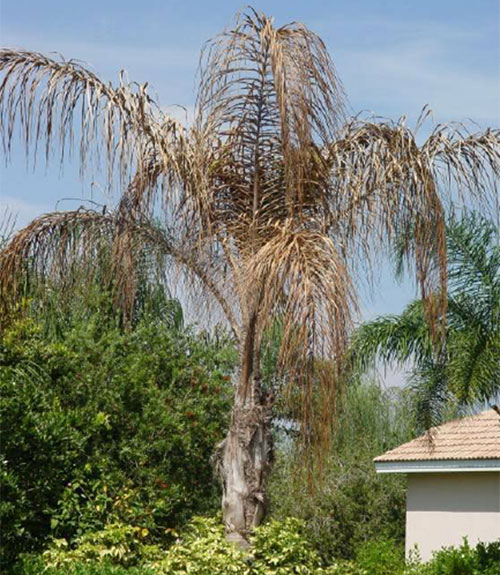
Queen Palm - Fusarium Wilt
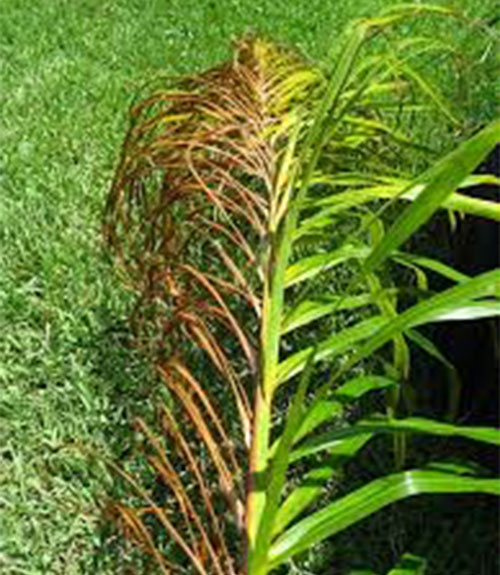
Symptoms - Fusarium Wilt
Ganoderma Butt Rot
What is it? Ganoderma is a lethal disease of palms, both in the landscape and in natural settings. All palms are considered hosts of this fungal disease. No known environmental conditions or landscape management practices favor the development of this disease. The fungus spreads by spores which are produced and spread by the conk. The pathogen will degrade the lignin and the cellulose in the lower 4-5 feet of the trunk. As the disease destroys the palm wood internally, the water conduction tissue will also be affected.
Symptoms: The primary symptom of Ganoderma butt rot typically is observed as wilting or an overall general decline of the palm. The disease can be confirmed prior to palm death by observing a conk on the trunk. However, it is common for conks not to appear prior to severe decline and the death of the palm. This hard shell-like structure will be attached to the lower 4-5 feet of the palm trunk. A palm can also be diagnosed with Ganoderma butt rot by the internal discoloration of the trunk that is observed once the palm is cut down.
Remedies: There are no cultural or chemical controls for preventing this disease or for curing a palm once it becomes infected. Removal of the palm is the only remedy. It is not recommended to replace an infected palm with another palm.
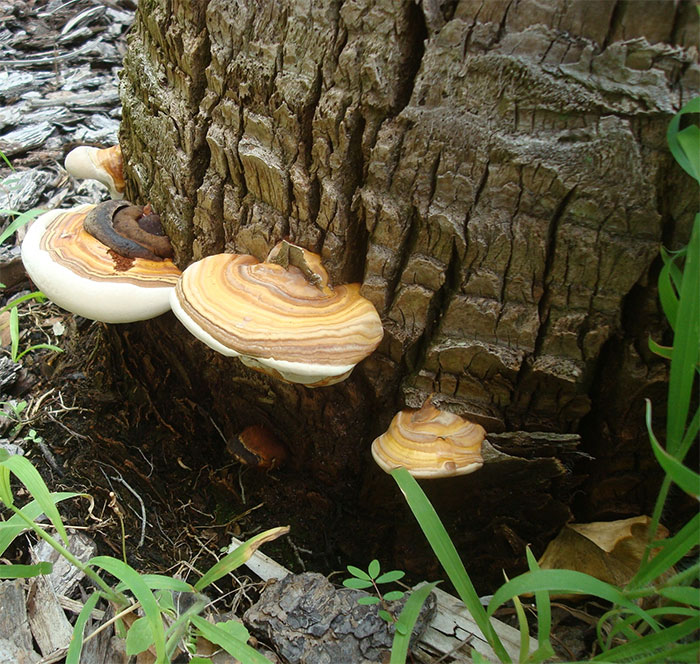
Ganoderma Conks.
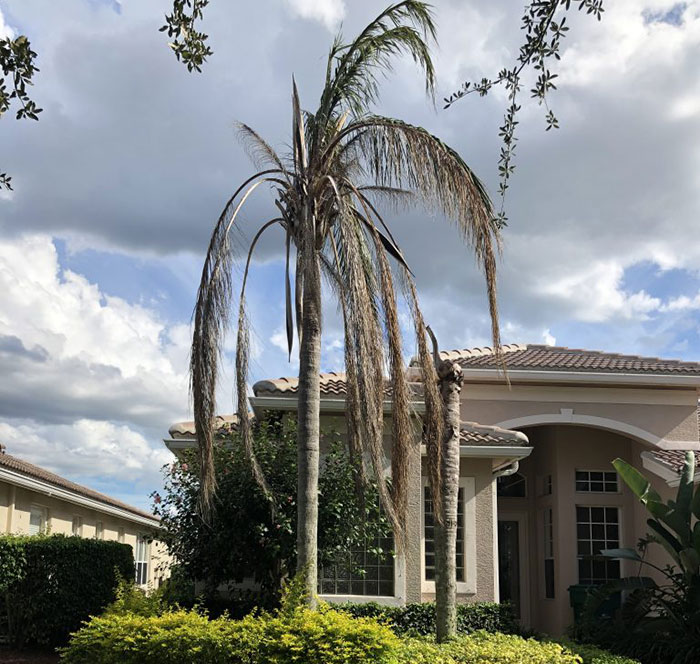
Ganoderma disease symptom - Queen Palm
Graphiola Leaf Spot (False Smut)
What is it? Graphiola leaf spot or false smut is a disease that commonly effects Phoenix canariensis and Phoenix dactylifera palms.
Symptoms: This disease can be easily diagnosed by the examination of the affected leaf tissue. When this disease is present, very small, black, cupped shaped fungal bodies are present on the leaf blades of the oldest foliage. These can be easily seen without the need for magnification.
Remedies: This disease is primarily cosmetic and does not adversely affect the palms growth in the landscape. Remove the diseased leaves only if the palm is not exhibiting nutrient deficiencies. An application of a manganese-based fungicide will aid to manage this disease. This fungicide application will not eliminate the False smut that is already present, but it will protect the leaf tissue from future disease.
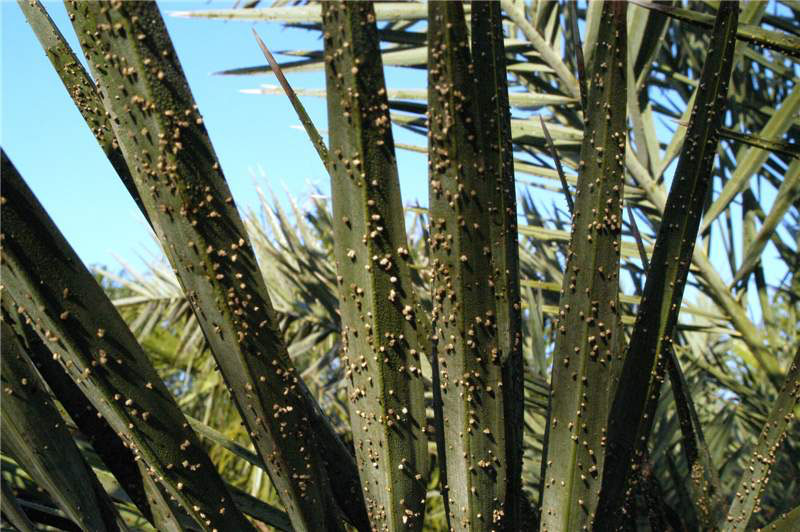
Date Palm - False Smut
Thielaviopsis Trunk Rot
What is it? All palms are considered potential hosts for this fungus. This fungal disease enters the palm through fresh wounds. The diseased tissue will have a fermented fruit odor.
Symptoms: This disease is most often observed in the upper third of the trunk. The palm trunk either collapses on itself or the canopy suddenly falls off the trunk, often without warning. The palm can appear healthy prior to collapse. Stem bleeding is a common symptom of this disease with Coconut palms; however, all other species of palms have no symptoms of this disease.
Remedies: There are no methods to prevent or cure this disease. The diseased palm should be removed immediately, and the trunk portion destroyed.
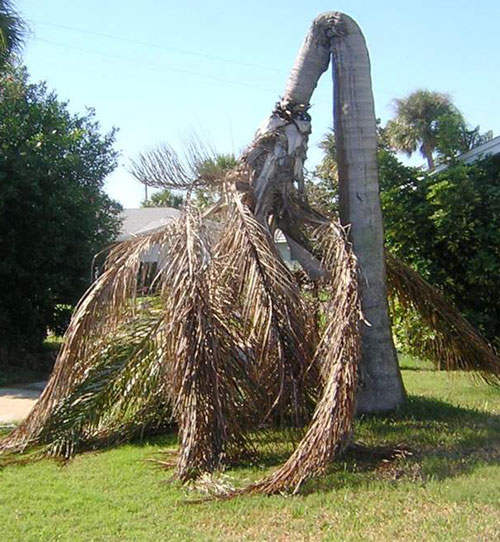
Queen Palm Trunk Rot
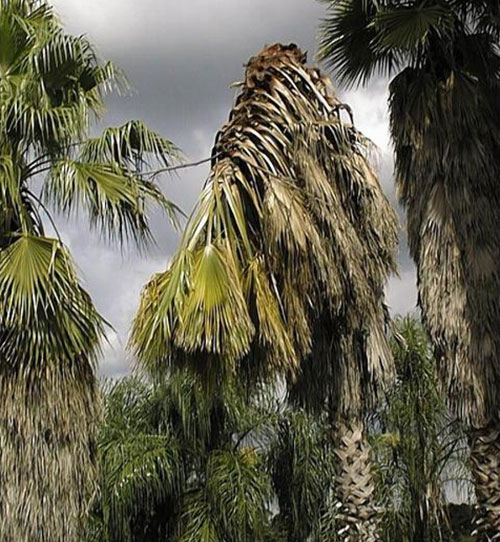
Washingtonia Palm Trunk Rot
Bud Rot
What is it? Bud rot disease in palms is most commonly caused by the pathogen Phytophthora palmivora. This fungus is found worldwide and causes disease on numerous plants besides palms. Its host-range within the palm family is wide. This disease is observed in nurseries and in the landscape among all stages of palm development. This fungus produces spores that can be found in water and soil and can be moved by wind or water. Bud rot is most likely to occur during the rainy season and appears to occur with greater frequency after a tropical storm or hurricane. Bud rot is also observed in association with cold damage. Cold damage allows entry of secondary fungi and bacteria pathogens.
Symptoms: The first symptom of Bud rot is the discoloration and wilting of the spear leaf and the next youngest leaf. When the disease is severe, the spear leaf easily pulls out from the bud. Lack of new leaves and an open topped crown are additional symptoms that can be observed in diseased palms. These older leaves can remain healthy for months after the bud dies.
Remedies: Disease control of mature palms is difficult. Unless the bud rot is caught very early, the palm usually dies. Fungicides may be useful as a preventive measure on palms in close proximity to a palm that has died from bud rot.
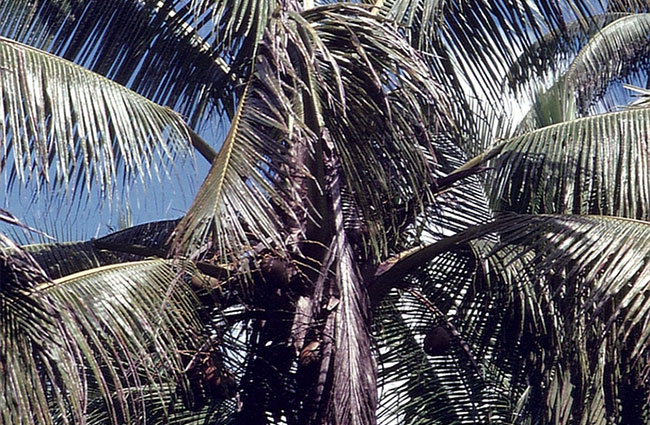
Coconut Palm Bud Rot
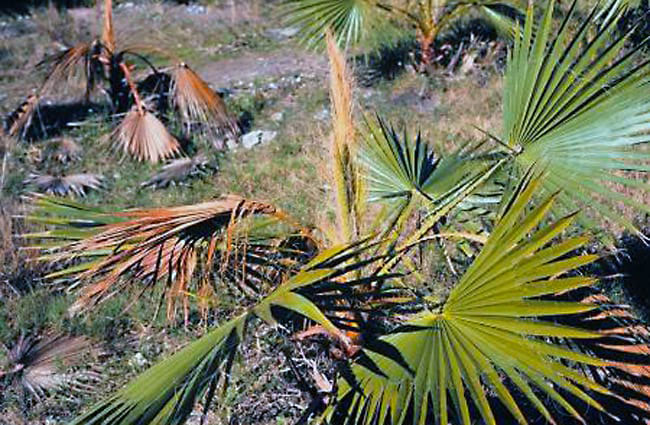
Washingtonia Palm Bud Rot
Conclusion
Although there are a number of palm diseases in Florida, the impact these diseases have on the palms in the landscape can be managed. Understanding the symptoms of these diseases helps to identify the problem, and keep it in control. Sometimes, all it takes to ensure the investment of the palm is a well-trained eye. When installing a new palm, it is important to keep in mind both the quality of the sourced palm and the surrounding environmental conditions to ensure it will thrive.
